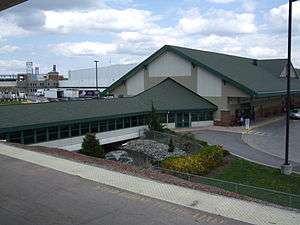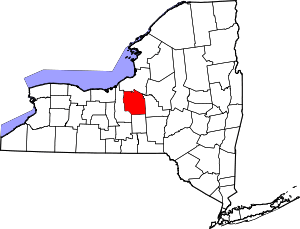Syracuse, New York
| Syracuse, New York | |
|---|---|
| City | |
|
A view of the downtown Syracuse skyline | |
| Nickname(s): The 'Cuse, Salt City, Emerald City, The Heart of New York | |
 Location in Onondaga County and the state of New York. | |
 Syracuse, New York Location in the USA | |
| Coordinates: 43°02′49″N 76°08′40″W / 43.04694°N 76.14444°WCoordinates: 43°02′49″N 76°08′40″W / 43.04694°N 76.14444°W | |
| Country |
|
| State |
|
| County | Onondaga |
| Incorporated | 1825 (village) |
| Incorporated | 1847 (city) |
| Government | |
| • Type | Mayor-Council |
| • Mayor | Stephanie A. Miner (D) |
| • Common Council |
Members' List
|
| Area | |
| • City | 26.6 sq mi (66.4 km2) |
| • Land | 26 sq mi (65 km2) |
| • Water | 0.6 sq mi (1.4 km2) 2.15% |
| Elevation | 380 ft (116 m) |
| Population (2013) | |
| • City | 144,669 |
| • Density | 5,583.5/sq mi (2,233.4/km2) |
| • Metro | 662,577 |
| Demonym(s) | Syracusan |
| Time zone | Eastern (UTC−5) |
| • Summer (DST) | Eastern Daylight Time (UTC−4) |
| Area code(s) | 315 |
| FIPS code | 36-73000 |
| GNIS feature ID | 0966966 |
| Website | www.Syracuse.ny.us |
Syracuse (local /ˈsɛrəkjuːs/) is a city in, and the county seat of, Onondaga County, New York, in the United States. It is the largest U.S. city with the name "Syracuse", and is the fourth most populous metropolitan city in the state of New York.[1] At the 2010 census, the city population was 145,170, and its metropolitan area had a population of 732,117. It is the economic and educational hub of Central New York, a region with over a million inhabitants. Syracuse is also well-provided with convention sites, with a downtown convention complex. Syracuse was named after the original Greek city Syracuse (Siracusa in Italian), a city on the eastern coast of the Italian island of Sicily.
The city has functioned as a major crossroads over the last two centuries, first between the Erie Canal and its branch canals, then of the railway network. Today, Syracuse is located at the intersection of Interstates 81 and 90, and its airport is the largest in the region. Syracuse is home to Syracuse University, a major research university, as well as several smaller colleges and professional schools. In 2010, Forbes rated Syracuse 4th in the top 10 places in the U.S. to raise a family.[2]
History
The Syracuse area was first seen by Europeans when French missionaries came to the area in the 1600s. At the invitation of the Onondaga Nation, one of the five constituent members of the Iroquois confederacy, a group of Jesuit priests, soldiers, and coureurs des bois (including Pierre Esprit Radisson) set up a mission, known as Sainte Marie among the Iroquois, or Ste. Marie de Gannentaha, on the northeast shore of Onondaga Lake.
Jesuit missionaries visiting the Syracuse region in the mid 1600s reported salty brine springs around the southern end of "Salt Lake", known today as Onondaga Lake. The 1788 Treaty of Fort Stanwix, and the subsequent designation of the area by the state of New York as the Onondaga Salt Springs Reservation provided the basis for commercial salt production from the late 1700s through the early 1900s; brine from wells that tapped into halite (common salt) beds in the Salina shale near Tully, New York, 15 miles south of the city were developed in the 19th century.[3][4] It is the north flowing brine from Tully that is the source of salt for the "salty springs" found along the shoreline of Onondaga lake. The rapid development of this industry in the 18th and 19th centuries led to the nicknaming of Syracuse as "The Salt City". In 1847, the city was officially named after Syracuse, Sicily, which at the time was also famous for its salt mining industry.

The first Solvay Process Company plant in the United States was erected on the southwestern shore of Onondaga Lake in 1884 and the village was given the name Solvay, New York to commemorate its inventor, Ernest Solvay. In 1861, he developed the ammonia-soda process for the manufacture of soda ash (anhydrous sodium carbonate, a rare chemical called natrite, to distinguish it from natural natron of antiquity) from brine wells dug in the southern end of Tully valley (as a source of sodium chloride) and limestone (as a source of calcium carbonate). The process was an improvement over the earlier Leblanc process. The Syracuse Solvay plant was the incubator for a large chemical industry complex owned by Allied Signal in Syracuse, the result of which made Onondaga Lake the most polluted in the nation.
The salt industry declined after the Civil War, but a new manufacturing industry arose in its place.
Throughout the late 1800s and early 1900s, numerous businesses and stores were established, including the Franklin Automobile Company, which produced the first air-cooled engine in the world; the Century Motor Vehicle Company; and the Craftsman Workshops, the center of Gustav Stickley's handmade furniture empire.
The Geneva Medical College was founded in 1834. It is now known as Upstate Medical University, one of only four medical colleges in the State University of New York system, and one of only five medical schools in the state north of New York City.
The first New York State Fair was held in Syracuse in 1841.[5] Between 1842 and 1889 the Fair traveled among 11 New York cities before finding a permanent home in Syracuse, where it has been an annual event except between 1942 and 1947, when the grounds became a military base during World War II.[5]
World War II sparked significant industrial expansion in the area: specialty steel, fasteners, custom machining. After the war, two of the Big Three automobile manufacturers (General Motors & Chrysler) had major operations in the area. Syracuse was headquarters for Carrier Corporation, Crouse-Hinds traffic signal manufacturing, and General Electric had its main television manufacturing plant at Electronics Parkway in Syracuse.
The manufacturing industry in Syracuse began to falter in the 1970s. Many small businesses failed during this time, which contributed to an already increasing unemployment rate. Rockwell International moved their factory outside New York state. General Electric moved its television manufacturing operations to Suffolk, Virginia and later to Singapore. The Carrier Corporation moved its headquarters out of Syracuse and outsourced manufacturing to Asian locations. Nevertheless, although city population has declined since 1950, the Syracuse metropolitan area population has remained fairly stable, even growing by 2.5 percent since 1970. While this growth rate is greater than much of Upstate New York, it is far below the national average during that period.
Geography and climate
Geography

Syracuse is located at 43°2′49″N 76°8′40″W / 43.04694°N 76.14444°W (43.046899, -76.144423).[6]
According to the United States Census Bureau, the city has a total area of 25.6 square miles (66 square kilometres), of which 25.1 square miles (65 square kilometres) is land and 0.6 square miles (1.6 square kilometres) (2.15%) water.
The city stands at the northeast corner of the Finger Lakes region. The city has many neighborhoods which were originally various villages that joined the city over the years. Although the central part of Syracuse is flat, many of its neighborhoods are located on small hills such as University Hill and Tipperary Hill. Land to the north of Syracuse is generally flat while land to the south is hilly.
About 27 percent of Syracuse's land area is covered by 890,000 trees — a higher percentage than in Albany, Rochester or Buffalo. This is despite the Labor Day Storm of 1998, a derecho which destroyed approximately 30,000 trees. The sugar maple accounts for 14.2 percent of Syracuse's trees, followed by the Northern white cedar (9.8 percent) and the European buckthorn (6.8 percent). The most common street tree is the Norway maple (24.3 percent) followed by the honey locust (9.3 percent). The densest tree cover in Syracuse is in the two Valley neighborhoods, with 46.6 percent of their land covered by trees. The lowest tree cover percentage is found downtown, which consists of only 4.6 percent trees.[7]
Syracuse's main water source is Skaneateles Lake, one of the country's cleanest lakes,[8] located 15 miles (24 kilometres) southwest of the city. Water from nearby Onondaga Lake is not drinkable due to industrial dumping that spanned many decades, leaving the lake heavily polluted.[9] Incoming water is left unfiltered,[10] and chlorine is added to prevent bacterial growth. Most of the lake cleanup is scheduled to be completed by 2016; the county is scheduled to finish its work by 2018.[11] For periods of drought, there is also a backup line which uses water from Lake Ontario.[12]
Onondaga Creek, a waterway that runs through downtown, flows northward through the city. There is a creek walk and plans that will connect the Lakefront and Inner Harbor to Franklin Square, Armory Square, The Valley, and ultimately the Onondaga Nation. The creek is navigable, yet can be quite a challenge as its channelized nature speeds up its flow, particularly in the spring, when it may be dangerous. Drownings of youngsters resulted in fencing of the creek through some residential areas.
Climate

Syracuse has a humid continental climate and is known for its snowfall. Boasting 115.6 inches (294 centimetres) on average,[13] Syracuse receives the most annual average snow of any metropolitan area in the United States.[14][15] Syracuse usually wins the Golden Snowball Award, among Upstate cities. Its record so far is 192.1 inches (488 centimetres).[16] The high snowfall is a result of the fact that the city receives both lake effect from nearby Lake Ontario and nor'easter snow. Snow most often falls in small (about 1–3 inches or 2.5–7.6 centimetres), almost daily doses, over a period of several days. Larger snowfalls do occur occasionally, and even more so in the northern suburbs.
One notable blizzard was the Blizzard of 1993, during which 42.9 inches (109 centimetres) fell on the city within 48 hours, with 35.6 inches (90 centimetres) falling within the first 24 hours. Syracuse received more snow than any other city in the country during this storm, which shattered a total of eight local records, including the most snow in a single snowstorm.[17] A second notable snowfall was the Blizzard of 1966, with 42.3 inches (107 cm). The Blizzard of '58 occurred in February (16-17th) across Oswego and Onondaga counties. This storm was an actual blizzard due to the high winds, blowing snow and cold. 26.1 inches (66 cm) of snow was measured at Syracuse and drifts reached 20 feet (600 cm) in Oswego County. (See Thirtieth Publication of the Oswego County Historical Society, (1969) and The Climate and Snow Climatology of Oswego N.Y., (1971)) February 1958 was the snowiest month ever in Syracuse, with a record 72.6 inches (184 cm) recorded in 28 days. Syracuse shivered under a white blanket that averaged 4 feet (120 cm) on February 19. Syracuse declared a snow emergency under a new law that allowed municipalities to demand that streets be cleared of vehicles to help with plowing operations.[18]
Syracuse receives an annual rainfall of 41.54 inches (105.51 centimeters).[19]
Syracuse's hottest month is historically July, with an average high temperature of 82 °F (28 °C), while its coldest month is historically January, with an average high temperature of 31 °F (−1 °C). The record high of 102 °F (39 °C) was recorded on July 9, 1936, and the record low of −26 °F (−32 °C) has occurred three times since 1922, the last being February 18, 1979.[20]
While the average high during summer is around the low 80s, when adding humidity, the apparent temperature highs extend upward in the range of mid-80s to mid-90s in the city. Days just shy of 100 °F (38 °C), such as 96 or 97 °F (36 °C), are not uncommon in and around the city with the humidity factored in. However, days above 100 °F (38 °C) are more rare, even with humidity taken into account.
A few recent summers in Syracuse have been warmer than previous ones in the city and, like in some other places in the nation, previous records have been broken. For example, the summers of 2005 and 2012 are, respectively, the hottest and fourth-hottest summers on record.[21]
| Climate data for Syracuse Hancock International Airport, New York (1981–2010 normals,[lower-alpha 1] extremes 1902–present[lower-alpha 2]) | |||||||||||||
|---|---|---|---|---|---|---|---|---|---|---|---|---|---|
| Month | Jan | Feb | Mar | Apr | May | Jun | Jul | Aug | Sep | Oct | Nov | Dec | Year |
| Record high °F (°C) | 70 (21) |
69 (21) |
87 (31) |
92 (33) |
96 (36) |
100 (38) |
102 (39) |
101 (38) |
98 (37) |
87 (31) |
81 (27) |
72 (22) |
102 (39) |
| Mean maximum °F (°C) | 55.4 (13) |
54.4 (12.4) |
70.0 (21.1) |
80.8 (27.1) |
86.3 (30.2) |
90.6 (32.6) |
92.1 (33.4) |
91.4 (33) |
86.6 (30.3) |
78.0 (25.6) |
68.8 (20.4) |
57.6 (14.2) |
93.6 (34.2) |
| Average high °F (°C) | 31.5 (−0.3) |
34.2 (1.2) |
43.2 (6.2) |
57.2 (14) |
68.8 (20.4) |
77.5 (25.3) |
81.6 (27.6) |
80.0 (26.7) |
72.2 (22.3) |
60.0 (15.6) |
48.4 (9.1) |
36.4 (2.4) |
57.7 (14.3) |
| Average low °F (°C) | 15.7 (−9.1) |
17.6 (−8) |
25.1 (−3.8) |
36.6 (2.6) |
46.4 (8) |
56.0 (13.3) |
61.0 (16.1) |
59.6 (15.3) |
51.9 (11.1) |
41.2 (5.1) |
32.8 (0.4) |
22.4 (−5.3) |
39.0 (3.9) |
| Mean minimum °F (°C) | −7.8 (−22.1) |
−3.7 (−19.8) |
4.3 (−15.4) |
23.4 (−4.8) |
33.2 (0.7) |
42.8 (6) |
50.3 (10.2) |
47.6 (8.7) |
36.8 (2.7) |
27.2 (−2.7) |
17.3 (−8.2) |
1.4 (−17) |
−10.7 (−23.7) |
| Record low °F (°C) | −26 (−32) |
−26 (−32) |
−16 (−27) |
7 (−14) |
25 (−4) |
34 (1) |
44 (7) |
38 (3) |
25 (−4) |
18 (−8) |
4 (−16) |
−26 (−32) |
−26 (−32) |
| Average precipitation inches (mm) | 2.50 (63.5) |
2.07 (52.6) |
2.95 (74.9) |
3.19 (81) |
3.22 (81.8) |
3.31 (84.1) |
3.78 (96) |
3.57 (90.7) |
3.69 (93.7) |
3.44 (87.4) |
3.53 (89.7) |
3.22 (81.8) |
38.47 (977.1) |
| Average snowfall inches (cm) | 34.0 (86.4) |
25.3 (64.3) |
18.0 (45.7) |
3.8 (9.7) |
0.1 (0.3) |
0 (0) |
0 (0) |
0 (0) |
0 (0) |
0.4 (1) |
9.5 (24.1) |
32.7 (83.1) |
123.8 (314.5) |
| Average precipitation days (≥ 0.01 in) | 19.1 | 16.0 | 15.8 | 14.0 | 12.9 | 12.1 | 11.3 | 10.8 | 12.1 | 14.2 | 16.7 | 18.6 | 173.6 |
| Average snowy days (≥ 0.1 in) | 18.4 | 14.4 | 9.9 | 2.6 | 0.1 | 0 | 0 | 0 | 0 | 0.5 | 5.8 | 14.7 | 66.4 |
| Average relative humidity (%) | 73.2 | 72.3 | 69.6 | 65.2 | 67.1 | 69.9 | 70.5 | 74.9 | 76.4 | 74.3 | 75.4 | 76.8 | 72.1 |
| Mean monthly sunshine hours | 102.8 | 116.7 | 172.5 | 204.4 | 243.1 | 260.6 | 289.3 | 247.1 | 193.0 | 144.3 | 76.7 | 69.0 | 2,119.5 |
| Percent possible sunshine | 35 | 40 | 47 | 51 | 53 | 57 | 62 | 57 | 51 | 42 | 26 | 25 | 48 |
| Source: NOAA (relative humidity and sun 1961–1990),[23][24][25] | |||||||||||||
Demographics
| Historical population | |||
|---|---|---|---|
| Census | Pop. | %± | |
| 1850 | 22,271 | — | |
| 1860 | 28,119 | 26.3% | |
| 1870 | 43,051 | 53.1% | |
| 1880 | 51,792 | 20.3% | |
| 1890 | 88,143 | 70.2% | |
| 1900 | 108,374 | 23.0% | |
| 1910 | 137,249 | 26.6% | |
| 1920 | 171,717 | 25.1% | |
| 1930 | 209,326 | 21.9% | |
| 1940 | 205,967 | −1.6% | |
| 1950 | 220,583 | 7.1% | |
| 1960 | 216,038 | −2.1% | |
| 1970 | 197,208 | −8.7% | |
| 1980 | 170,105 | −13.7% | |
| 1990 | 163,855 | −3.7% | |
| 2000 | 146,070 | −10.9% | |
| 2010 | 145,170 | −0.6% | |
| Est. 2015 | 144,142 | [26] | −0.7% |
| Historical Population Figures[27] | |||
As of the census of 2010,[28] there were 145,170 people, 57,355 households, and 28,455 families residing in the city. The racial makeup of the city was 56.0% White, 29.5% African American, 1.1% Native American, 5.5% Asian, 0.03% Pacific Islander, 2.7% from other races, and 5.1% from two or more races. Hispanic or Latino of any race were 8.3% of the population. The largest ancestries include Irish (12.4%), Italian (12.3%), German (9.6%), English (4.5%), and Polish (3.6%).[29] Non-Hispanic Whites were 52.8% of the population in 2010,[30] down from 87.2% in 1970.[31]
There were 57,355 households out of which 29% had children under the age of 18 living with them, 9.3% were married couples living together, 20.8% had a female householder with no husband present, and 50.4% were non-families. 38.4% of all households were made up of individuals and 10.4% had someone living alone who was 65 years of age or older. The average household size was 2.31 and the average family size was 3.14.
In the city, the population was spread out with 19% under the age of 15, 23% from 15 to 24, 25.6% from 25 to 44, 21.7% from 45 to 64, and 10.5% who were 65 years of age or older. The median age was 29.6 years. For every 100 females there were 91 males. For every 100 females age 18 and over, there were 87.89 males.
According to the 2014 estimates from the American Community Survey, the median income for a household in the city was $31,566, and the median income for a family was $38,794. Males had a median income of $39,537 versus $33,983 for females. The per capita income for the city was $19,283. About 28.2% of families and 35.1% of the population were below the poverty line, including 50% of those under age 18 and 16.7% of those age 65 and over.
As of July 2015, the United States Census Bureau indicated an estimated population of 144,142.
According to the 2010 United States Census, the population ages 16 and older commuted to work as follows:
- 64.1% drive alone
- 9.7% carpool
- 11.4% walk
- 8.6% use public buses (CENTRO)
- 1.2% bike
- 1.6% use a taxicab
Syracuse currently ranks 50th in the United States for high transit ridership and 12th for most pedestrian commuters. Each day, 38,332 people commute into Onondaga County from the four adjoining counties (2006).[32]
Work Area Profile Report[33]
Worker Age
| Count | Share(%) | |
|---|---|---|
| Age 29 or younger | 22,597 | 22.6 |
| Age 30 to 54 | 53,867 | 53.8 |
| Age 55 or older | 23,694 | 23.7 |
Earnings
| per month | Count | Share(%) |
|---|---|---|
| $1,250 or less | 23,734 | 23.7 |
| $1,251 to $3,333 | 30,833 | 30.8 |
| More than $3,333 | 45,591 | 45.5 |
Religion
| Religion[34] | % of Population |
|---|---|
| Percent religious | 55.57% |
| Catholicism | 35.90% |
| Christianity | 16.2% |
| Judaism | 0.87% |
| Eastern religion (Hinduism, Buddhism, Sikhism) | 1.20% |
| Islam | 1.14% |
Christianity: Syracuse has two cathedrals, the Roman Catholic Cathedral of the Immaculate Conception and the Episcopal St. Paul's Cathedral. Both are located at Columbus Circle. Both are home to their respective dioceses, the Diocese of Syracuse (Roman Catholic) and the Diocese of Central New York (Episcopal). The Assembly of God, the Southern Baptist Convention and the United Church of Christ have their state offices in the Greater Syracuse area. Syracuse is also home to the novitiate center of the Jesuit New York Province, as well as the Basilica of the Sacred Heart of Jesus (Roman Catholic, with Mass offered in English and Polish). In addition there are dozens of churches in Syracuse of nearly every Christian denomination, including Eastern Orthodox, Jehovah's Witness, Christian Science, Reformed Presbyterian and Metaphysical Christian.
Buddhism: Buddhism has its presence in Syracuse too with the Zen Center of Syracuse on the Seneca Turnpike; as well as a center on Park Street, on the city's north side.
Hinduism: Hindu houses of worship include the Hindu Mandir of Central New York in Liverpool.
Islam: Islam also has a presence in Syracuse, with the Islamic Society of Central New York Mosque on Comstock Avenue and Muhammad's Study Group on West Kennedy Street.
Judaism: There are several synagogues in the Syracuse metropolitan area, including Beth Shalom-Chevra Chas, Temple Adath Yeshurun, and the Temple Society of Concord, which is considered to be the ninth oldest Jewish House of Worship in the United States.
Sikhism: Sikh The house of worship, or Gurdawara, is the Sikh Foundation of Syracuse, in Liverpool.
Unitarian Universalism: There are two Unitarian Universalist Societies in Syracuse including May Memorial Unitarian Society and First Unitarian Universalist Society of Syracuse.
Economy
Syracuse's economy has faced challenges over the past decades as industrial jobs have left the area. The number of local and state government jobs also has been declining for several years. Syracuse's top employers are now primarily in education and the service industry. University Hill is Syracuse's fastest growing neighborhood, fueled by expansions by Syracuse University and Upstate Medical University (a division of the State University of New York), as well as dozens of small medical office complexes.
Top employers
The top employers in the Syracuse region and the size of their workforce, as of January 1, 2008:[35]
- State University of New York Upstate Medical University: 6,400
- Syracuse University: 5,925
- Wegmans Food Markets: 3,760
- St. Joseph's Hospital Health Center: 3,150
- Magna International: 600 (Closed as of August 2012)
- Crouse Hospital: 2,400
- Lockheed Martin Corp.: 2,350
- National Grid USA: 1,860
- Loretto (elder care services): 1,825
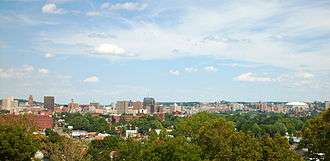
Bristol-Myers Squibb, founded by alumni of nearby Hamilton College, has a complex in East Syracuse.[36] Time Warner Cable has based one of its divisions in Syracuse.[37]
Today the Syracuse area has few extremely large employers, but rather many smaller ones, which provides for a certain amount of stability. Additionally, eight of the area's top eleven employers are in education or the service industry, which tend to be much more stable than the manufacturing industry.
Throughout 2006, the area gained jobs over the previous year's figures. During February and March 2006, the area's job growth rate tied with New York City for the highest in the state.[38]
Syracuse's unemployment rate in July 2016 was 4.7 percent, comparable to the national rate of 5.1.[39]
Tallest buildings
Since 1927 the State Tower Building has been the tallest in Syracuse.
| Name | Height | Floors | Use | Built |
|---|---|---|---|---|
| The State Tower Building | 95 m | 23 | Office | 1928 |
| AXA Tower I | 82 m | 19 | Commercial office | 1966 |
| AXA Tower II | 82 m | 19 | Commercial office | 1971 |
Neighborhoods

The City of Syracuse officially recognizes 26 neighborhoods within its boundaries. Some of these have small additional neighborhoods and districts inside of them. In addition, Syracuse also owns and operates Syracuse Hancock International Airport, located on the territory of four towns north of the city.
Syracuse's neighborhoods reflect the historically ethnic and multicultural population. Traditionally, Irish, Polish and Ukrainian Americans settled on its westside; Jewish Americans on its eastside; German and Italian Americans on the northside; and African-Americans on its southside.
Business districts
In addition to the dominant Destiny USA shopping mall in the Syracuse's Lakefront neighborhood, many of the city's more traditional neighborhoods continue to have active business districts:
- Downtown: Armory Square has replaced South Salina Street as the main retail and dining area of Downtown Syracuse. Armory Square has around 30 dining establishments, around 20 pubs, bars and clubs, and over 50 other retail stores. Similarly, but on a smaller scale, there is the Hanover Square area.
- Eastwood: Calling itself "the village within the city", this former village still has a retail corridor along James Street.
- Little Italy: A neighborhood with Italian origins, Little Italy (part of the Near Northeast neighborhood) has several blocks of bakeries, restaurants, pizzerias, shops, and services.
- University Hill: Marshall Street, along with its terminus South Crouse Avenue, is lined with stores, bars, and restaurants, primarily catering to the student population on "The Hill", as well as the over 25,000 people who work there daily. East Genesee Street at the northwestern corner of the neighborhood has several retail establishments, as well.
- Westcott: This neighborhood, located east of University Hill, is inhabited by a wide variety of people, increasingly including some college students as the university grows but still primarily local families and residents. Single-family homes and two-unit apartments comprise the majority of housing. Westcott is known as a bohemian and liberal quarter, and each September hosts the Westcott Street Cultural Fair. The main business district is on Westcott Street between Beech and Dell streets and includes restaurants, bars, a consignment shop, and other businesses.
 Eastwood
Eastwood Armory Square
Armory Square Tipperary Hill
Tipperary Hill Strathmore
Strathmore- Clinton Square
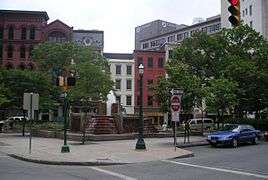 Hanover Square
Hanover Square University Hill
University Hill Westcott
Westcott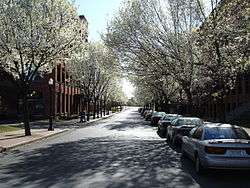 Franklin Square
Franklin Square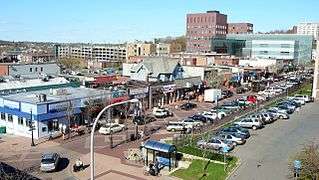 Marshall Street
Marshall Street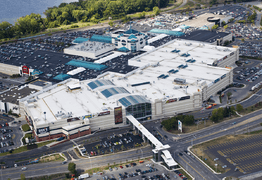 Destiny USA
Destiny USA- Inner Harbor
Education
Primary and secondary schools
Residents are assigned to schools in the Syracuse City School District.[40] Syracuse City School District consists of 34 schools and 4 alternative education programs.[41] In the 2014-2015 school year, the K-12 enrollment was 20,084.[5] 15% of students were classified as English Language Learners, 20% as students with disabilities, and 77% as economically disadvantaged.[5] The drop-out rate was 6%.[5] Syracuse City School District is currently collaborating with Say Yes to Education with the goal of every public school student graduating high school with the preparation and support to attain, afford, and complete a college or other postsecondary education.[42] They are also one of the "Big 5," which consists of the five New York State School districts with populations over 125,000.[43] "Big 5" school budgets are approved by annually by the Board of Education and city government as opposed to voters in an annual vote.[43]
Colleges and universities
One of Syracuse's major research universities is Syracuse University, located on University Hill. It had an enrollment of 15,097 for the 2013–2014 academic year.[44]
Immediately adjacent to Syracuse University are two doctoral-degree granting State University (SUNY) schools, the SUNY College of Environmental Science and Forestry and SUNY Upstate Medical University. Both institutions have long-standing ties to Syracuse University. SUNY Upstate Medical University is also one of Syracuse's major research universities and is one of only about 125 academic medical centers in the country. It is the region's largest employer.[45]
Also serving Syracuse are Le Moyne College on the city's eastern border, and Onondaga Community College, which has its main campus in the adjacent Town of Onondaga and has two smaller campuses downtown and in Liverpool. A branch of SUNY's Empire State College is located in downtown Syracuse, along with a campus of the nationwide Bryant & Stratton College. A campus of ITT Technical Institute also calls the Syracuse metropolitan area home, also located in Liverpool. There are also the Pomeroy College of Nursing at Crouse Hospital and St. Joseph's College of Nursing.
Other colleges and universities in the area include Cornell University and Ithaca College in Ithaca, Hamilton College in Clinton, Oswego State College in Oswego, SUNY Cortland in Cortland, Morrisville State College in Morrisville, Colgate University in Hamilton, Cazenovia College in Cazenovia, Wells College in Aurora, and both Utica College and SUNY Institute of Technology in Utica.
Public libraries
Onondaga County Public Library (OCPL) operates Syracuse's public libraries.[46] Including the Central Library, ten city libraries, and 21 independent libraries in suburban Onondaga County.[47] A library card from any OCPL library will work at any of the other OCPL libraries.[48]
City libraries [49]
- Central Library
- Beauchamp Branch Library
- Betts Branch Library
- Hazard Branch Library
- Mundy Branch Library
- Northeast Community Center Library
- Paine Branch Library
- Petit Branch Library
- Soule Branch Library
- Southwest Community Center Library
- White Branch Library
Subrurban libraries [50]
- Baldwinsville Public Library
- Brewerton NOPL
- Cicero NOPL
- DeWitt Community Library
- East Syracuse Free Library
- Elbridge Free Library
- Fairmount Community Library
- Fayetteville Free Library
- Jordan Bramley Library
- LaFayette Public Library
- Liverpool Public Library
- Manlius Library
- Marcellus Free Library
- Maxwell Memorial Library
- Minoa Library
- North Syracuse NOPL
- Onondaga Free Library
- Salina Library
- Skaneateles Library
- Solvay Public Library
- Tully Free Library
Arts and culture
.jpg)
Performing arts
Live jazz music is the centerpiece of two annual outdoor festivals in Syracuse, the Syracuse Jazz Festival, Polish Festival as well as the CNY Jazz Arts Foundation's Jazz In The Square Festival. Performers in the last five years have included Chuck Mangione, Joshua Redman, Smokey Robinson, Branford Marsalis, The Bad Plus, Randy Brecker, Stanley Clarke, Jimmy Heath, Terrence Blanchard, Slide Hampton, Bobby Watson, Dr. John, and Aretha Franklin. The Polish Festival hosted Grammy winners Jimmy Sturr and his Orchestra, Polish music legend Stan Borys and Irena Jarocka, Grammy nominee Lenny Goumulka, LynnMarie, Dennis Polisky & The Maestro's Men, Jerry Darlak and the Buffalo Touch & The John Gora Band.
Syracuse was home to the 75-member Syracuse Symphony Orchestra (SSO), founded in 1961. The SSO's former Music Directors include Daniel Hege, Frederik Prausnitz and Kazuyoshi Akiyama. The orchestra performed over 200 concerts annually for an audience of over 250,000. The SSO filed for Chapter 7 Bankruptcy in 2011 and was replaced by the Syracuse Symphoria in 2013.[51]
The Clinton String Quartet has been active for over 15 years and is based in the Syracuse area. All four members were also members of the Syracuse Symphony Orchestra.
The Syracuse Friends of Chamber Music for more than a half century have presented a series of concerts by various chamber ensembles.
The Society for New Music, founded in 1982, is the oldest new music organization in the state outside of New York City, and the only year-round new music group in upstate New York. The Society commissions at least one new work each year from a regional composer, awards the annual Brian Israel Prize to a promising composer under 30 years of age, and produces the weekly "Fresh Ink" radio broadcast for WCNY-FM.
The Syracuse Opera Company is a professional company that generally performs three operas each season. It was founded in 1963 as the Opera Chorus of the Syracuse Symphony Orchestra and became independent in 1973. In addition to full performances, it offers several free outdoor concerts each year in Armory Square, Thornden Park, and elsewhere. The company has an annual budget of US$1 million and is the only professional opera company in upstate New York.
The Syracuse Shakespeare Festival is a charitable, educational, not-for-profit corporation dedicated to performing the works of William Shakespeare. It was founded in 2002 and is best known for its annual free Shakespeare-in-the-Park program at the Thornden Park Amphitheatre that has attracted more than 12,000 people since its inception.
Syracuse Stage presents experimental and creative theater; a number of its productions have been world premieres and have moved to Broadway. The venue was designed by its most famous former artistic director Arthur Storch. Its current artistic director is Robert Hupp.
The Red House Arts Center, which opened in 2004, is a small theatre housed in a converted hotel that offers performances by local, national, and international artists, and hosts regular exhibits in its art gallery, and screenings of independent films.
Syracuse is also known for a large contemporary music scene, particularly in the heavy metal, hardcore, ska, and punk rock genres.
Museums and art galleries
- Everson Museum of Art, which opened in 1968 in a building designed by I.M. Pei, features one of the most extensive pottery collections in the United States along with works of American art, dating from the 18th century to the present. This collection includes paintings, sculptures, drawings, photography, and video.
- Erie Canal Museum is a museum dedicated to preserving the history of the Erie Canal and its role in Syracuse's growth.
- International Mask and Puppet Museum is a museum in Little Italy focusing on masks and puppets, the later of which are also used in educational performances for children.
- Milton J. Rubenstein Museum of Science and Technology is a museum located in the Armory Square neighborhood that features exhibits in science and technology.
- Onondaga Historical Association Museum & Research Center, located at 321 Montgomery Street downtown, features exhibits on the past of the Syracuse region, and contains historical archives relating to the area's history. Its exhibits include a presentation of the history of the Underground Railroad.
- The Warehouse Gallery is located at 350 West Fayette Street in The Warehouse. It is a part of the Coalition of Museum And Art Centers (CMAC). This new contemporary art center exhibits, commissions, and promotes work by emerging and accomplished artists in a variety of media. The programming attempts to engage the community in a dialogue regarding the role the arts can play in illuminating the critical issues of our times.
- Spark Contemporary Art Space is located at 1005 E. Fayette St. in the Downtown area. Spark is run by Syracuse University graduate art students, but is a venue for a diversity of non-university affiliated events. The gallery's directors curate and organize art and music related events, while local artists can rent the space to hold their own events. With the initiation of a monthly video screening series in 2001, Spark became one of the leading venues for video art in Syracuse. Spark Video provides the community an opportunity to see video work from local and international artists.
- Delavan Art Gallery is located at 501 West Fayette Street in an old farm equipment factory. It has a 3,800 square feet (350 m2) of exhibit space, and, on several other floors in the building, houses the studios of a number of area artists. It has shows which usually open on the first Thursday of the month. It showcases a wide variety of work, from multi-media sculpture to hyperrealism.
- Point of Contact Gallery is located at 914 East Genesee Street. The newest member of the Coalition of Museums and Art Centers at Syracuse University, it is a space dedicated to the exploration of the verbal and visual arts and home of the Point of Contact Art Collection. It is a cross-disciplinary open forum for the essential discussion of contemporary art. A showcase for contemporary artists from around the world, with a strong prevalence from Latin America. The Point of Contact collection comprises over 200 original pieces created especially for "Point of Contact", the book series, since 1975. Photography, collage, drawings, paintings and three-dimensional works form this rare collection.
Parks and recreation

The City of Syracuse maintains over 170 parks, fields, and recreation areas, totaling over 1,000 acres (4.0 km2).[52] Burnet Park includes the first public golf course in the United States (1901) and Rosamond Gifford Zoo. Other major parks include Thornden Park, Schiller Park, Sunnycrest Park, Onondaga Park and Kirk Park. There are 12 public pools, two public ice rinks, and two public nine-hole golf courses in the city.
Right outside the city proper, along the east side and north end of Onondaga Lake, is Onondaga Lake Park. The adjacent Onondaga Lake Parkway is closed to vehicular traffic several hours on Sundays during the summer months, so it can be used for walking, running, biking, and rollerblading. During the holiday season, the park hosts Lights on the Lake, a two-mile (3.2 km) drive-through light show.
Infrastructure
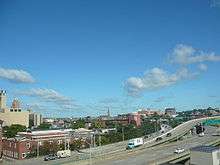
Transportation
Public transit
Syracuse is served by the Central New York Regional Transportation Authority, or Centro. Centro operates bus service in Syracuse and its suburbs, as well as to outlying metropolitan area cities such as Auburn, Fulton, and Oswego.
Proposed public transit projects
In 2005, local millionaire Tom McDonald proposed an aerial tramway system, called Salt City Aerial Transit (S.C.A.T.), to link the university to the transportation center. The first segment from Syracuse University to downtown was estimated to cost $5 million, which McDonald planned to raise himself. Due perceived low operating costs, the system was envisioned as running continuously.[53]
The Pyramid Companies have also proposed a monorail linking Syracuse University to Hancock International Airport, via downtown, (Downtown Syracuse), their proposed Destiny USA, the William F. Walsh Regional Transportation Center, and their proposed Destiny Technology Park. The cost of such a line has been estimated at $750 million.[54]
Rail
The city lies on Amtrak's Empire Service, Lake Shore Limited, and Maple Leaf lines. Amtrak's station is part of the William F. Walsh Regional Transportation Center.
The Empire Service runs several times daily from Niagara Falls to New York Penn Station, with major stops in Buffalo, Rochester, Syracuse, Utica, and Albany along the way.
The Lake Shore Limited connects Syracuse to the same cities as above (except Niagara Falls), but continues westward from Buffalo to Chicago via Cleveland and Toledo, and eastward to Boston. This train completes one roundtrip daily. Also completing one roundtrip a day, the Maple Leaf follows the path of the Empire Service train, but continues to Toronto, Canada.
A regional commuter rail service, OnTrack, was active from 1994 until it was discontinued in 2007 due to low ridership. Its sole route connected the Carousel Center to southern Syracuse, often extending to Jamesville in the summer.
Bus
Greyhound Lines and Trailways provide long-distance bus service. Both also use the William F. Walsh Regional Transportation Center located in the northern area of the city.
Air service
Syracuse is served by the Syracuse Hancock International Airport in nearby Salina, near Mattydale. The airport is served by 6 major airlines, which provide non-stop flights to destinations as far away as Minneapolis, as well as several daily flights to other important airline hubs and business centers such as Atlanta, Boston, Charlotte, Chicago, Detroit, Ft. Lauderdale, New York City, Orlando, Philadelphia, Tampa, Washington, DC, Toronto, and 147 foreign cites from 87 different countries, not including USA. Cargo carriers FedEx and UPS also serve the airport. New York City can be reached in under an hour flight.
Major highways and roads

Four Interstate Highways run through the Syracuse area:
-
 Interstate 81 (Highway 401 via Highway 137 in Ontario to Knoxville) runs north-south through Syracuse, and provides access to Canada, Pennsylvania and points south. Its downtown portion is extremely narrow, only consisting of four lanes and essentially no onramps.
Interstate 81 (Highway 401 via Highway 137 in Ontario to Knoxville) runs north-south through Syracuse, and provides access to Canada, Pennsylvania and points south. Its downtown portion is extremely narrow, only consisting of four lanes and essentially no onramps. -
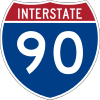 Interstate 90 (Seattle to Boston), also known as the New York State Thruway runs east-west, just north of the city. It is a toll highway that provides access to Rochester, Buffalo, Albany, and the north-south (Interstate 87) part of the Thruway which leads to New York City.
Interstate 90 (Seattle to Boston), also known as the New York State Thruway runs east-west, just north of the city. It is a toll highway that provides access to Rochester, Buffalo, Albany, and the north-south (Interstate 87) part of the Thruway which leads to New York City. -
 Interstate 690 runs east-west through the city, and provides access to Interstate 90, as well as to Syracuse's northwestern and eastern suburbs. A spur off I-690 directly west of the city, NY 695, provides freeway access to the southwestern suburbs. It meets Interstate 81 in downtown Syracuse in a highly complex and incomplete intersection. Most of its routing through the city directly replaced elevated rail lines, a fact quite notable by the city's former main rail terminal, where the freeway spans the width between the terminal and its outermost platform. In 1981 artist Duke Epolito erected sculptures of "passengers" on the far platform. The piece is entitled "Waiting for the Night Train."[55]
Interstate 690 runs east-west through the city, and provides access to Interstate 90, as well as to Syracuse's northwestern and eastern suburbs. A spur off I-690 directly west of the city, NY 695, provides freeway access to the southwestern suburbs. It meets Interstate 81 in downtown Syracuse in a highly complex and incomplete intersection. Most of its routing through the city directly replaced elevated rail lines, a fact quite notable by the city's former main rail terminal, where the freeway spans the width between the terminal and its outermost platform. In 1981 artist Duke Epolito erected sculptures of "passengers" on the far platform. The piece is entitled "Waiting for the Night Train."[55] -
 Interstate 481 forms an eastern loop around the city and continues to the northwest as NY 481 to Fulton and Oswego, on the shore of Lake Ontario.
Interstate 481 forms an eastern loop around the city and continues to the northwest as NY 481 to Fulton and Oswego, on the shore of Lake Ontario.
Two US Highways run through the Syracuse area:
-
 U.S. Highway 11 (Route 223 in Quebec to New Orleans) passes through Syracuse, including downtown, and it follows the route of Salina and State Streets.
U.S. Highway 11 (Route 223 in Quebec to New Orleans) passes through Syracuse, including downtown, and it follows the route of Salina and State Streets. -
 U.S. Highway 20 (Boston to Newport, Oregon) passes south of Syracuse.
U.S. Highway 20 (Boston to Newport, Oregon) passes south of Syracuse.
New York State Route Expressways:
-
 New York State Route 481 - Travels from NY 104 in Oswego to the junction of Interstate 81 and Interstate 481 north of Syracuse.
New York State Route 481 - Travels from NY 104 in Oswego to the junction of Interstate 81 and Interstate 481 north of Syracuse. -
 New York State Route 690 - Was built as an extension of Interstate 690 in the northwest suburbs of Syracuse. The route is a four-lane divided highway from its southern end at I-690, where it meets Interstate 90 (NYS Thruway), to its end northwest of Baldwinsville in Lysander at NY 48 and NY 631.
New York State Route 690 - Was built as an extension of Interstate 690 in the northwest suburbs of Syracuse. The route is a four-lane divided highway from its southern end at I-690, where it meets Interstate 90 (NYS Thruway), to its end northwest of Baldwinsville in Lysander at NY 48 and NY 631. -
 New York State Route 695 - Is a short state highway located west of Syracuse in the town of Solvay in Onondaga County. The number of the highway was derived from the two highways that NY 695 links, Interstate 690 and NY 5.
New York State Route 695 - Is a short state highway located west of Syracuse in the town of Solvay in Onondaga County. The number of the highway was derived from the two highways that NY 695 links, Interstate 690 and NY 5.
Public works
Public services such as garbage pickup, street plowing, sewage, street and park maintenance, and traffic maintenance are provided by the Department of Public Works (DPW).[56]
Utilities
The Syracuse water system was one of the few water systems that was built and operated before federal funding. The water system was constructed mainly to support the industries around Syracuse, New York. Construction of Syracuse's water system began in 1868.[57]
In 2015, the city experienced an average of at least one water main break per day. Between 2005 and 2015, the city suffered 2,000 water main breaks. Mayor Stephanie Miner estimated of the cost to fix the city's water infrastructure at $1 billion over a 10-15 year period.[58] On February 25, 2015, Miner testified before a joint hearing of the state Assembly Ways and Means Committee and state Senate Finance Committee. Miner testified that the 2014 polar vortex contributed to the increase in Syracuse's water main break.[59]
On March 3, the 100th water main break in Syracuse in 2015 occurred on James Street.[60] Early in 2015, Miner lobbied the state for funding to fix the city's aging water system. New York Governor Andrew Cuomo declined to help, stating that the city should improve its economy and increase tax revenues, which would enable the city to fund their own water pipe repairs.[61]
Government
Executive
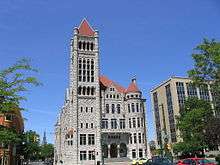
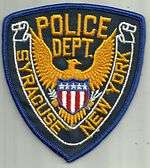
The city is headed by an elected mayor who is limited to two four-year terms. The previous mayor until the end of 2009 was former Syracuse Common Council President Matthew J. Driscoll,[62] who first assumed the position in 2001 after the former mayor, Roy Bernardi, resigned upon his appointment by President George W. Bush to a position in the Department of Housing and Urban Development. After serving the remaining term, Driscoll was re-elected that year, and again in 2005. Driscoll is a member of the Mayors Against Illegal Guns Coalition,[63] a bi-partisan group with a stated goal of "making the public safer by getting illegal guns off the streets." The Coalition is co-chaired by Boston Mayor Thomas Menino and New York City Mayor Michael Bloomberg.
On November 3, 2009, Common Councilor At Large Stephanie Miner was elected Mayor. She began to serve in this capacity in January 2010. She is the first female mayor of Syracuse.
Legislative
The legislative branch of Syracuse is the Syracuse Common Council. It consists of a president and nine members, currently:[64]
|
|
Judicial
The Onondaga County Supreme and County Court is the trial court of general jurisdiction for Syracuse. It is also the administrative court for the Fifth District of the New York State Unified Court System. Judges for these courts are elected at-large.
The U.S. District Court for the Northern District of New York also holds court in downtown Syracuse at the James Hanley Federal Building.
Police department

The Syracuse Police Department, commonly referred to as the Syracuse Police, or simply SPD, is the principal law enforcement agency of the city of Syracuse, New York.[65] Police headquarters is located in the John C. Dillon Public Safety Building at 511 South State Street.[66] As of 2014, the Chief of Police is Frank L. Fowler.[67] The 2015–2016 budget for the police department was $47.4 million[68]
Established in 2011, SPD operates a network of 91 surveillance cameras called the Criminal Observation and Protection System (COPS).[69][70] Between 2011 and 2014 more than 40 utility pole mounted cameras were installed, mainly in the Southwest and Northeast neighborhoods.[71] The cameras were funded by federal, state, and private grants. In Summer 2014, 10 cameras were approved for installation in Downtown Syracuse, the first area not targeted because of high levels of violent crime.[72] Live monitoring of Clinton Square for suspicious people during events and festivals was planned, although police agreed to a prohibition on the use of cameras to monitor protests.[73] Twenty-five additional cameras were planned to be installed in 2016.[70]
Fire department
The Syracuse Fire Department, or SFD, protects the city of Syracuse from fires and other dangers. The Department's Chief is Paul Linnertz.[74]
Media
Newspapers
Syracuse has one major daily morning newspaper, The Post-Standard. Until 2001, Syracuse also had an evening paper, The Herald-Journal. Besides a Syracuse/Onondaga County edition, The Post-Standard publishes three additional editions: Cayuga, Madison, and Oswego for the other three counties of the metropolitan area, plus an additional edition on Sundays. It has six news bureaus throughout Central New York, as well as one in Albany (state capital) and Washington, DC.
Before the merger with the evening paper, the Post-Standard was named among the "10 best newspapers in America with a circulation of under 100,000" by Al Neuharth of USA Today (run by a competing organization). Since the merger, circulation has increased to over 120,000. Even outside of its four-county delivery area, the paper is available in many convenience stores and supermarkets from the Canada–US border to the New York–Pennsylvania border. The newspaper partly caters to this audience as well, covering many stories from the Ithaca, Utica, and Watertown areas. Since opening a new printing press in 2002, the paper calls itself "America's Most Colorful Newspaper," as almost every page contains color.
Syracuse New Times is a weekly, free, arts and entertainment newspaper. The publication is released every Wednesday, with over 137,600 readers, and is distributed to over 950 locations in Central New York. Launched in 1969, it is one of the oldest alternative weekly newspapers in the country. It is owned by Bill Brod, who purchased the business from long-time owner Arthur Zimmer in 2010.
The Daily Orange, the newspaper of Syracuse University and SUNY ESF students, is read by over 20,000 people daily, and is widely distributed in the University Hill neighborhood and Armory Square. The Dolphin, the weekly student newspaper of Le Moyne College is also available, but read mainly by Le Moyne students.
There are other popular free newspapers, including Eagle Newspaper's downtown edition, the City Eagle, and Table Hopping, which focuses on the restaurant and entertainment scene. Additionally, there's a weekly newspaper, CNY Vision, that publishes news and information focusing on the local African American community.
Television
Syracuse has eight full-power broadcast television stations:
Additionally, networks such as Cornerstone Television channel 11 & 22, Univision, and MTV2 are broadcast by low-power television stations.[75]
Syracuse University's student-run TV station is CitrusTV. CitrusTV programming is broadcast on the university campus on the Orange Television Network. The station also provides content to Spectrum Sports. Online, CitrusTV programs can be found on CitrusTV.net and the Post-Standard's Syracuse.com.
Syracuse's cable television provider is Time Warner Cable (a subsidiary of Charter Communications through its acquisition of TWC), which, as a part of its regular and digital offerings, provides a 24-hour local news channel (Spectrum News Central New York), local sports channel, public access channel, and an additional PBS channel.
Dish Network and DirecTV also provide local satellite television subscribers with local broadcast stations.
Sports
Current teams
| Club | Sport | League | Founded | Venue | League titles |
Championship years |
|---|---|---|---|---|---|---|
| Syracuse Chiefs | Baseball | IL | 1934 | Alliance Bank Stadium | 8 | 1935, 1942, 1943, 1947, 1954, 1969, 1970, 1976 |
| Syracuse Crunch | Hockey | AHL | 1994 | War Memorial at Oncenter | 0 | N/A |
| Syracuse Silver Knights | Indoor Soccer | MASL | 2011 | War Memorial at Oncenter | 0 | N/A |

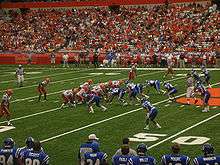
Professional teams in Syracuse include:
- Syracuse Chiefs (International League affiliate of the Washington Nationals) Stadium: NBT Bank Stadium
- Syracuse Crunch (American Hockey League affiliate of the Tampa Bay Lightning) Arena: War Memorial at Oncenter
- Syracuse Silver Knights (Major Arena Soccer League) Arena: War Memorial at Oncenter
College teams in Syracuse include:
- Syracuse University Orange (NCAA Division I-A), stadium: Carrier Dome
- Le Moyne College Dolphins (NCAA Division II)
- Onondaga Community College Lazers (NJCAA)
- SUNY Environmental Science and Forestry Mighty Oaks (USCAA)
Syracuse University sports are by far the most attended sporting events in the Syracuse area. Basketball games often draw over 30,000 fans, and football games over 40,000. The university has bred dozens of famous professional players since starting an athletics program in the late nineteenth century, including all-time greats Jim Brown, Larry Csonka and Dave Bing, and present professional stars Marvin Harrison, Carmelo Anthony, Dwight Freeney, Jason Hart, and Donovan McNabb. Both teams play in the Carrier Dome.
Notable people
Notable individuals who were born in and/or lived in Syracuse include actor Tom Cruise, voice of SpongeBob SquarePants Tom Kenny, and news anchor David Muir from ABC World News Tonight with David Muir.
Syracuse in film and television
Events
Sister cities
Syracuse's sister cities are:
See also
Notes
- ↑ Mean monthly maxima and minima (i.e. the expected highest and lowest temperature readings at any point during the year or given month) calculated based on data at said location from 1981 to 2010.
- ↑ Official records for Syracuse kept at downtown from August 1902 to April 1938, Syracuse Municipal Airport from May 1938 to 17 September 1949, and at Syracuse Hancock Int'l since 18 September 1949.[22]
References
- ↑
- ↑ "America's Best Places to Raise a Family". Forbes.com.
- ↑ Connors, Dennis J. (2006). Crossroads in Time. Syracuse: Onondaga Historical Association. p. 17. ISBN 0-8156-8149-6.
- ↑ Yager, Richard M.; Kappel, William M.; Plummer, L. Niel (2007-05-24). "Origin of halite brine in the Onondaga Trough near Syracuse, New York State, USA: modeling geochemistry and variable-density flow". Hydrogeology Journal. 15 (7): 1321–1339. doi:10.1007/s10040-007-0186-9. ISSN 1431-2174.
- 1 2 3 4 5 "State Fair History". The Great New York State Fair. New York State Government. Retrieved October 13, 2016.
- ↑ "US Gazetteer files: 2010, 2000, and 1990". United States Census Bureau. February 12, 2011. Retrieved April 23, 2011.
- ↑ Weiner, Mark: "Census of trees sees healthy population - Syracuse, one of Upstate's leafiest cities, is coming back after the devastating 1998 Labor Day Storm", Post-Standard, April 27, 2001
- ↑ "City of Syracuse". www.syracuse.ny.us. Retrieved 2016-12-02.
- ↑ Onondaga Lake
- ↑ "SYRACUSE - GEOGRAPHY OF SYRACUSE IN NEW YORK STATE | UNITED STATES GEOGRAPHY & HISTORY™". SYRACUSE - GEOGRAPHY OF SYRACUSE IN NEW YORK STATE | UNITED STATES GEOGRAPHY & HISTORY™. Retrieved 2016-12-02.
- ↑ "Onondaga Lake cleanup hits milestone this week with completion of barrier wall". syracuse.com. Retrieved 2016-10-13.
- ↑ City of Syracuse - Executive Summary (2003)
- ↑ "Snowfall - Average Total In Inches", NOAA, June 23, 2004
- ↑ Cappella, Chris: "Answers: 10 snowiest 'cities' aren't all in New York", USA Today, October 3, 2003
- ↑ Kirst, Sean: "We won't buckle under the Snowbelt's blows", Post-Standard, March 14, 2005
- ↑ "Log in to NewsBank". infoweb.newsbank.com. Retrieved 2016-10-13.
- ↑ Staff Reports: "A Storm for the records - Blizzard of 1993 brought 42.9 inches", Post-Standard, December 31, 2003
- ↑ McKelvey, B. (1995). Snow in the Cities: A History of America's Urban Response. University of Rochester Press. p. 133. ISBN 9781878822543. Retrieved August 1, 2015.
- ↑
- ↑ "NCDC: U.S. Climate Normals" (PDF). National Oceanic and Atmospheric Administration. Retrieved May 14, 2010.
- ↑ xmACIS2. NOAA Regional Climate Centers http://xmacis.rcc-acis.org/. Retrieved 11 September 2016. Missing or empty
|title=(help) Use "Seasonal Time Series" or "Extremes". - ↑ ThreadEx
- ↑ "NowData – NOAA Online Weather Data". National Oceanic and Atmospheric Administration. Retrieved 2011-12-29.
- ↑ "Station Name: NY SYRACUSE HANCOCK INTL AP". National Oceanic and Atmospheric Administration. Retrieved 2014-03-13.
- ↑ "WMO Climate Normals for SYRACUSE/HANCOCK INT'L ARPT NY 1961–1990". National Oceanic and Atmospheric Administration. Retrieved 2014-03-10.
- ↑ "Annual Estimates of the Resident Population for Incorporated Places: April 1, 2010 to July 1, 2015". Retrieved July 2, 2016.
- ↑ "Syracuse, New York Population History". Biggest U.S. Cities.
- ↑ "American FactFinder". United States Census Bureau. Retrieved May 11, 2016.
- ↑ "Syracuse, New York (NY) profile: population, maps, real estate, averages, homes, statistics, relocation, travel, jobs, hospitals, schools, crime, moving, houses, news, sex offenders". city-data.com. Retrieved May 11, 2016.
- ↑ "Syracuse (city), New York". State & County QuickFacts. U.S. Census Bureau. Retrieved April 20, 2012.
- ↑ "Race and Hispanic Origin for Selected Cities and Other Places: Earliest Census to 1990". U.S. Census Bureau.
- ↑ "Graphic of commuter traffic volume". Syracuse Central.
- ↑ "OnTheMap". onthemap.ces.census.gov. Retrieved 2016-10-13.
- ↑ "Syracuse, New York Religion". www.bestplaces.net. Retrieved 2016-10-13.
- ↑ Greater Syracuse Economic Council
- ↑ "Bristol-Myers Squibb: Syracuse, New York". bms.com. Retrieved August 1, 2015.
- ↑ Time Warner Cable's Syracuse Division
- ↑ Moriarty, Rick: "CNY Leads in Job Growth", Post-Standard, April 21, 2006
- ↑ "Syracuse Area Economic Summary" (PDF). New York-New Jersey Information Office - Bureau of Labor Statistics. August 31, 2016. Retrieved October 13, 2016.
- ↑ "The Syracuse City School District | Syracuse, NY". syracusecityschools.com. Retrieved August 1, 2015.
- ↑ "The Syracuse City School District | Syracuse, NY". www.syracusecityschools.com. Retrieved 2016-10-13.
- ↑ "About - Say Yes to Education - Syracuse". Say Yes to Education - Syracuse. Retrieved 2016-10-13.
- 1 2 "The Syracuse City School District | Syracuse, NY". www.syracusecityschools.com. Retrieved 2016-10-13.
- ↑ "Syracuse University | Best College | US News". colleges.usnews.rankingsandreviews.com. Retrieved August 1, 2015.
- ↑
- ↑ "Onondaga County Public Library". onlib.org. Retrieved August 1, 2015.
- ↑ "Locations | Onondaga County Public Library". www.onlib.org. Retrieved 2016-10-13.
- ↑ "Using Your Library Card | Onondaga County Public Library". www.onlib.org. Retrieved 2016-10-13.
- ↑ "City Libraries | Onondaga County Public Library". www.onlib.org. Retrieved 2016-10-13.
- ↑ "Suburban Libraries | Onondaga County Public Library". www.onlib.org. Retrieved 2016-10-13.
- ↑ "Symphoria plays for 34,000 fans after rising from bankrupt Syracuse symphony (video)". Syracuse.com. Retrieved October 28, 2015.
- ↑ City of Syracuse Department of Parks
- ↑ Moriarty, Rick (September 26, 2006). "High flying idea stuck". The Post-Standard.
- ↑ "The Monorail Society - 20 Year Anniversary. Part II - Monorail history in TMS's first 20 years". www.monorails.org. Retrieved 2016-10-13.
- ↑ Case, Dick (December 20, 2009). "Mystery Santa's helper each year puts the red scarves on statues along I-690". The Post-Standard. Syracuse Media Group. Retrieved November 13, 2015.
- ↑ "City of Syracuse". www.syracuse.ny.us. Retrieved 2016-10-13.
- ↑ "The Early Years | OCWA". www.ocwa.org. Retrieved 2016-10-13.
- ↑ "Mayor: Syracuse, N.Y., water infrastructure system in crisis". TI News Daily. March 23, 2015. Retrieved April 17, 2015.
- ↑ Miner, Stephanie (February 25, 2015). "Testimony - City of Syracuse" (PDF). City of Syracuse, New York. Retrieved April 17, 2015.
- ↑ Sturtz, Ken (March 4, 2015). "James Street water main break is Syracuse's 100th this year". The Post-Standard. Syracuse Media Group. Retrieved April 17, 2015.
- ↑ Weaver, Teri (February 4, 2015). "Cuomo to Syracuse: 'You are not sustainable. You need jobs, an economy, business'". The Post-Standard. Retrieved November 20, 2016.
- ↑ "City of Syracuse". Retrieved November 4, 2009.
- ↑ "Mayors Against Illegal Guns: Coalition Members".
- ↑ "City of Syracuse". www.syrgov.net. Retrieved 2016-10-13.
- ↑ "Syracuse Police Department - Syracuse, NY 13202". syracusepolice.org. Retrieved August 1, 2015.
- ↑ "Building Information".
- ↑ "Chief of Police at Syracuse Police Department".
- ↑ "2015-2016 Budget" (PDF). April 8, 2015. Retrieved 2016-10-13.
- ↑ "COPS Platform Cameras". Retrieved December 24, 2014.
- 1 2 "Syracuse police to spend $400,000 on more surveillance cameras". Syracuse Media Group. October 13, 2015. Retrieved December 16, 2015.
- ↑ "Where the cop cameras are: A map of Syracuse police video surveillance". Syracuse Media Group. June 7, 2014. Retrieved December 24, 2014.
- ↑ "Syracuse residents ask city for more security cameras". WRVO Public Media. May 20, 2014.
- ↑ "Syracuse Police plan live camera monitoring of Clinton Square". CNY Central. September 24, 2013. Retrieved December 24, 2014.
- ↑ http://www.syracuse.ny.us/fire_department.aspx
- ↑ CNY Media: Syracuse TV Stations Transmitters
- ↑ "Mayoral Proclamation regarding sister City" (PDF). October 2001. at Syracuse, Mayor Proclamations
External links
| Wikimedia Commons has media related to Syracuse, New York. |
| Wikivoyage has a travel guide for Syracuse. |
| Look up Syracuse in Wiktionary, the free dictionary. |
- Official website of the City of Syracuse, New York
- Syracuse Central
- Syracuse at DMOZ
- Syracuse.com – News website affiliated with The Post-Standard
- Syracuse Arts
- Buildings of Syracuse
- Collection of Central NY photos from davidmetraux.com
- Syracuse City Court information
- Syracuse Wiki – Community Edited Area Resource
-
 Syracuse (New York) travel guide from Wikivoyage
Syracuse (New York) travel guide from Wikivoyage - Images of Syracuse, NY Brewery advertising


